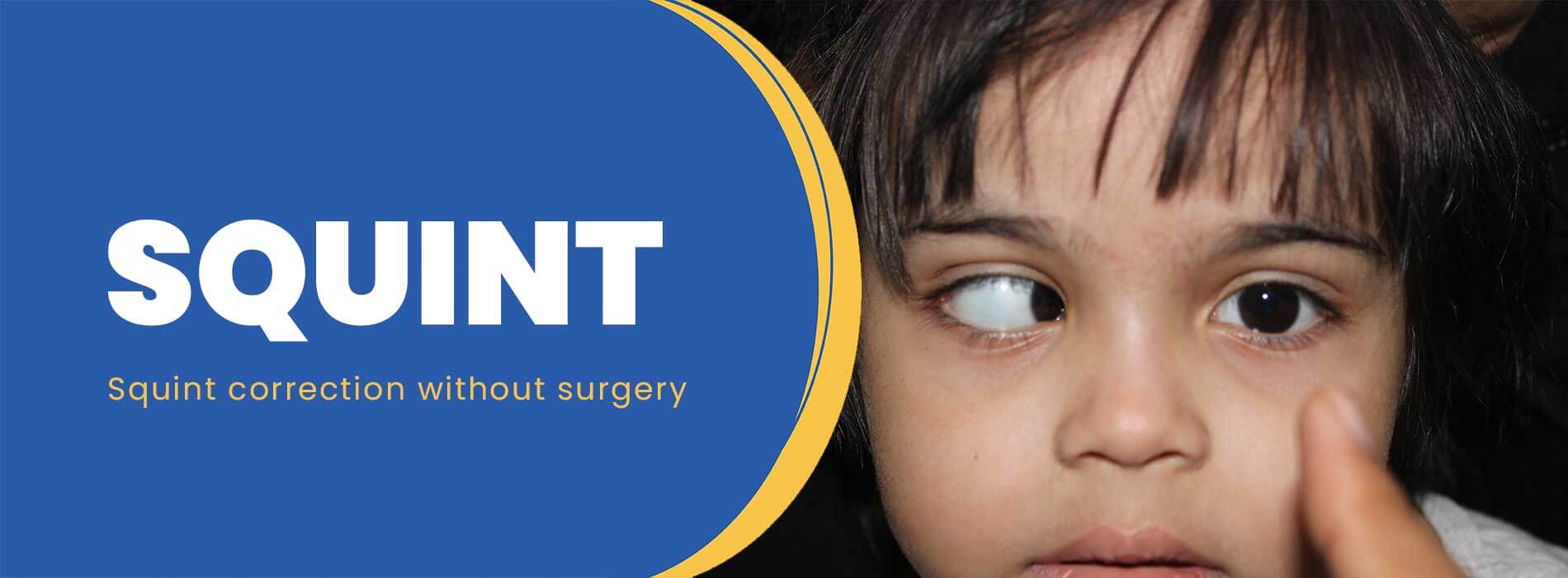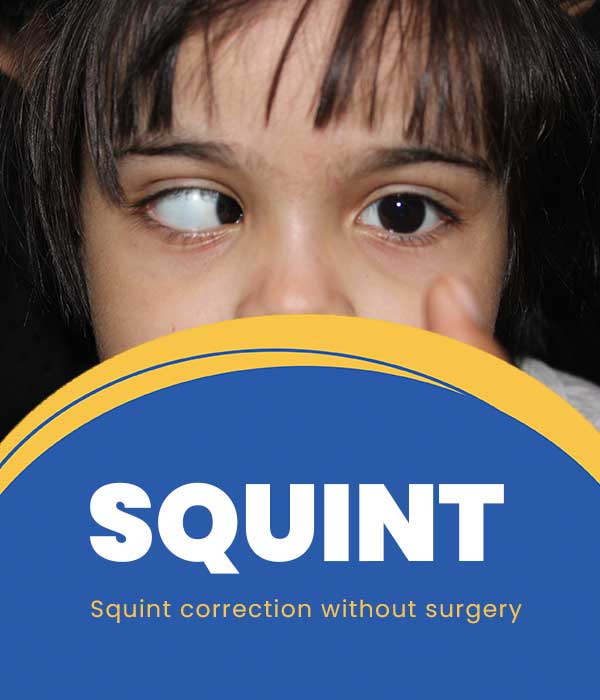

Squint
Best Advanced Treatment for Squint (Strabismus)
Squint (Strabismus) Treatment: Find the Best Squint Specialist Near You
Squint, medically known as strabismus, is a common eye condition where the eyes fail to align properly and point in different directions. This misalignment prevents both eyes from focusing on the same object simultaneously, which can affect vision quality and depth perception. If you or your child is experiencing signs of squint, it is crucial to consult a qualified squint specialist near you for timely diagnosis and effective treatment. Whether you require non-surgical squint treatment or surgical squint correction, early intervention by an expert squint ophthalmologist can make a significant difference.

Understanding Squint (Strabismus)
Squint can manifest in various forms depending on the direction of eye deviation. Some common types include:
- Esotropia – inward turning of one or both eyes
- Exotropia – outward turning
- Hypertropia – upward deviation
- Hypotropia – downward deviation
This condition can affect children and adults alike. In children, it may be noticed when one eye drifts inward or outward, often more visible after six months of age. Adult-onset squint can occur due to neurological conditions, trauma, or diseases affecting the eye muscles or nerves.
Why Early Diagnosis by a Squint Doctor is Essential
A squint doctor or ophthalmologist specializes in diagnosing and managing squint. Early evaluation ensures that underlying causes, such as refractive errors or amblyopia (lazy eye), are identified and treated promptly. Untreated squint can lead to permanent vision loss in one eye or impaired binocular vision, making everyday tasks and depth perception difficult.
How is Squint Diagnosed?
A thorough eye examination by a squint specialist involves assessing eye alignment using tools like the prism cover test, which measures the angle of deviation. The doctor may also check for eye movement abnormalities and evaluate visual acuity. Advanced imaging techniques help in understanding muscle function and planning the right course of treatment.
Non-Surgical Squint Treatment Options
Many cases of squint, especially in children, can be managed with non-surgical squint treatments such as:
- Prism glasses: These lenses help in redirecting light to assist the eyes in working together.
- Vision therapy (orthoptics): Eye exercises guided by an orthoptist strengthen eye coordination and improve focus.
- Botox injections: Botox can temporarily relax overactive eye muscles to help realign the eyes.
- Online gaming therapy: Innovative digital therapies engage children in vision exercises through interactive games, improving compliance and outcomes.
These non-invasive options are often the first line of treatment, especially when the squint is mild or detected early.
When is Surgical Squint Correction Needed?
A specialized squint ophthalmologist brings extensive expertise in both diagnosis and treatment, ensuring personalized care tailored to your condition. With access to the latest technologies and advanced surgical techniques, these specialists can deliver effective solutions, minimizing discomfort and maximizing success.
What to Expect During Squint Surgery?
Squint surgery is usually performed under general anesthesia, especially in children. The surgeon makes tiny incisions on the eye’s surface to access and adjust the muscles. The procedure typically lasts 30 minutes to 2 hours. Post-surgery, patients may experience mild discomfort, redness, or swelling, which usually resolves with proper care and medications.
Post-Treatment Care and Follow-Up
After squint treatment, whether surgical or non-surgical, follow-up visits with your squint doctor near you are essential. The doctor will monitor eye alignment, visual acuity, and eye health to ensure successful recovery. Vision therapy may continue post-surgery to reinforce coordination.
Choosing the Right Squint Specialist Near You
Selecting a trusted and experienced squint specialist near you is crucial for optimal outcomes. Look for clinics that offer comprehensive squint care, including advanced diagnostic tests, personalized treatment plans, and a multidisciplinary team of ophthalmologists, orthoptists, and therapists. Ashu Laser Vision and Ashu Eye Hospital in Andheri, Mumbai, is renowned for its expertise in managing all types of squints using cutting-edge technology and compassionate care.
The Importance of Early Intervention in Children
Children’s visual systems are still developing, so untreated squint during early years can lead to permanent vision problems. Early referral to a squint specialist ensures treatments like vision therapy or surgery can preserve or restore binocular vision.
Innovations in Squint Treatment
Modern squint treatment incorporates digital innovations like online gaming therapy, which uses engaging games to improve eye coordination, making therapy more enjoyable for children. Additionally, Botox therapy provides a minimally invasive option for selected cases, reducing the need for surgery.
Conclusion: Find the Best Squint Specialist Near You Today!
If you notice any signs of eye misalignment in yourself or your child, don’t delay seeking professional help. Whether you need non-surgical squint treatment or advanced surgical squint correction, a skilled squint ophthalmologist near you can restore eye alignment, improve vision, and enhance quality of life. Contact Ashu Laser Vision and Ashu Eye Hospital, Andheri Mumbai for expert squint care that combines experience, advanced technology, and personalized treatment.
Common FAQs About Squint Treatment
Squint, also known as strabismus, is a condition where the eyes do not align properly and point in different directions, causing problems with binocular vision and depth perception.
Squint in children is often caused by inherited eye muscle imbalance or refractive errors. In adults, it may result from neurological disorders, trauma, or eye muscle problems.
Signs include one eye turning inward, outward, upward, or downward, especially when focusing on objects. Parents may notice misaligned eyes during regular activities or photos.
You should consult a squint specialist as soon as you notice eye misalignment, especially in children, to prevent vision loss and improve treatment outcomes.
Diagnosis involves a comprehensive eye exam by a squint doctor, including tests like the prism cover test to measure eye deviation and assess binocular vision.
Yes, many cases can be managed with non-surgical squint treatments such as prism glasses, vision therapy (orthoptics), and Botox injections depending on the severity.
Vision therapy includes eye exercises designed to improve coordination and focus between the eyes, often supervised by an orthoptist or squint specialist.
Surgery is recommended when non-surgical methods are insufficient or the squint is severe, persistent, or affects vision significantly.
Squint surgery has a success rate of over 95% in achieving proper eye alignment, though some cases may require follow-up procedures.
Squint surgery is performed under anesthesia, so it is painless during the procedure. Postoperative discomfort is usually mild and manageable with medications.
Risks are minimal but may include infection, overcorrection or undercorrection, and temporary double vision. Your squint ophthalmologist will discuss these during consultation.
The surgery typically lasts between 30 minutes to two hours depending on the complexity and whether one or both eyes are treated.
Yes, adults can benefit from both non-surgical and surgical squint treatments to improve eye alignment and vision.
Prism therapy uses specially designed lenses to bend light entering the eye, helping to reduce double vision and improve eye coordination.
Yes, untreated squint can lead to amblyopia, where the brain favors one eye, causing poor vision development in the other.
Non-surgical treatments may take weeks to months, while surgical correction usually shows immediate improvement, with full recovery over weeks.
Yes, therapies like vision exercises, prism glasses, and online gaming therapy are effective non-invasive options for managing squint in children.
Botox injections can temporarily relax overactive eye muscles and are sometimes used as a non-surgical treatment option for certain types of squint.
Look for experienced ophthalmologists specializing in strabismus, preferably at reputed eye hospitals offering comprehensive squint diagnosis and treatment services.
Many insurance plans cover squint treatment, especially surgical procedures, but coverage varies. Consult your provider and squint specialist for details.

